LED test / review
EN
Osram OSTAR Projection Compact KW CSLNM1.TG / KW CSLPM1.TG
KW CSLNM1.TG-5N8N-ebvF46fcbB46-15B5
KW CSLPM1.TG-8N7P-ebvF46fcbB46
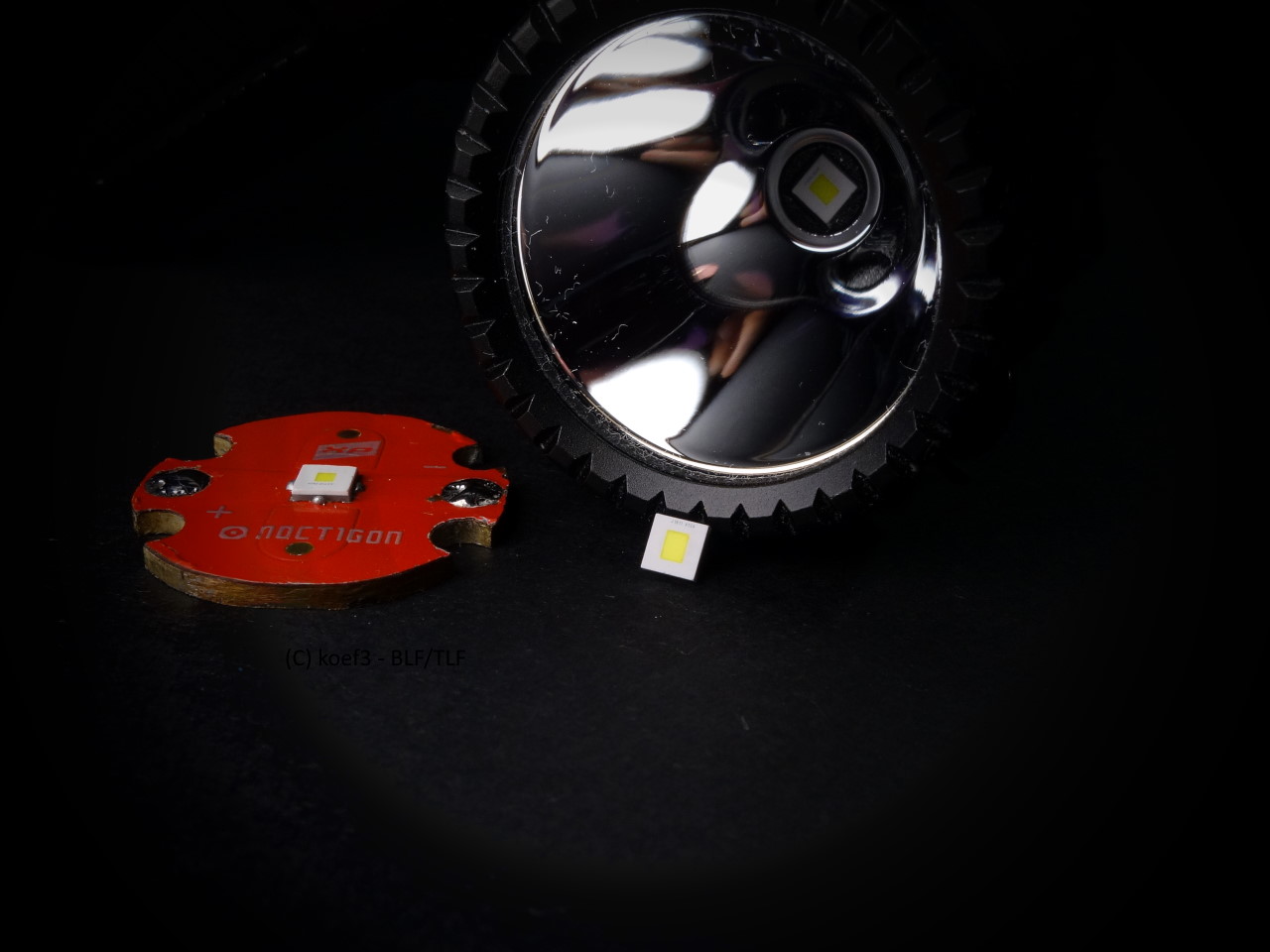
For years, Osram has been offering LEDs with very high luminance and attractive pricing. Once primarily intended for the automotive and projector market, Osram's LEDs of this type are also becoming increasingly popular with flashlight manufacturers and are installed in many pocket throwers.
Technical data
CSLNM1.TG |
CSLPM1.TG |
Tj 25 °C - If 1,000 mA
Type: single die, domeless
official datasheet here |
Tj 25 °C - If 1,400 mA
Type: single die, domeless
official datasheet here |
First appearance
For the sake of simplicity, the CSLNM1.TG is shown on the left and the CSLPM1.TG on the right in the further course of the test. Due to the very similar construction, the description applies to both models anyway; they primarily differ in the design of the light surface.
The LEDs have a white housing made of heat-resistant plastic. This is relatively brittle and breaks relatively easily, but there should be no problems with normal handling. The light area at the same height as the surrounding housing, which should minimize side light leaks. The phosphor is coated with a clear layer, protecting it from accidental damage.

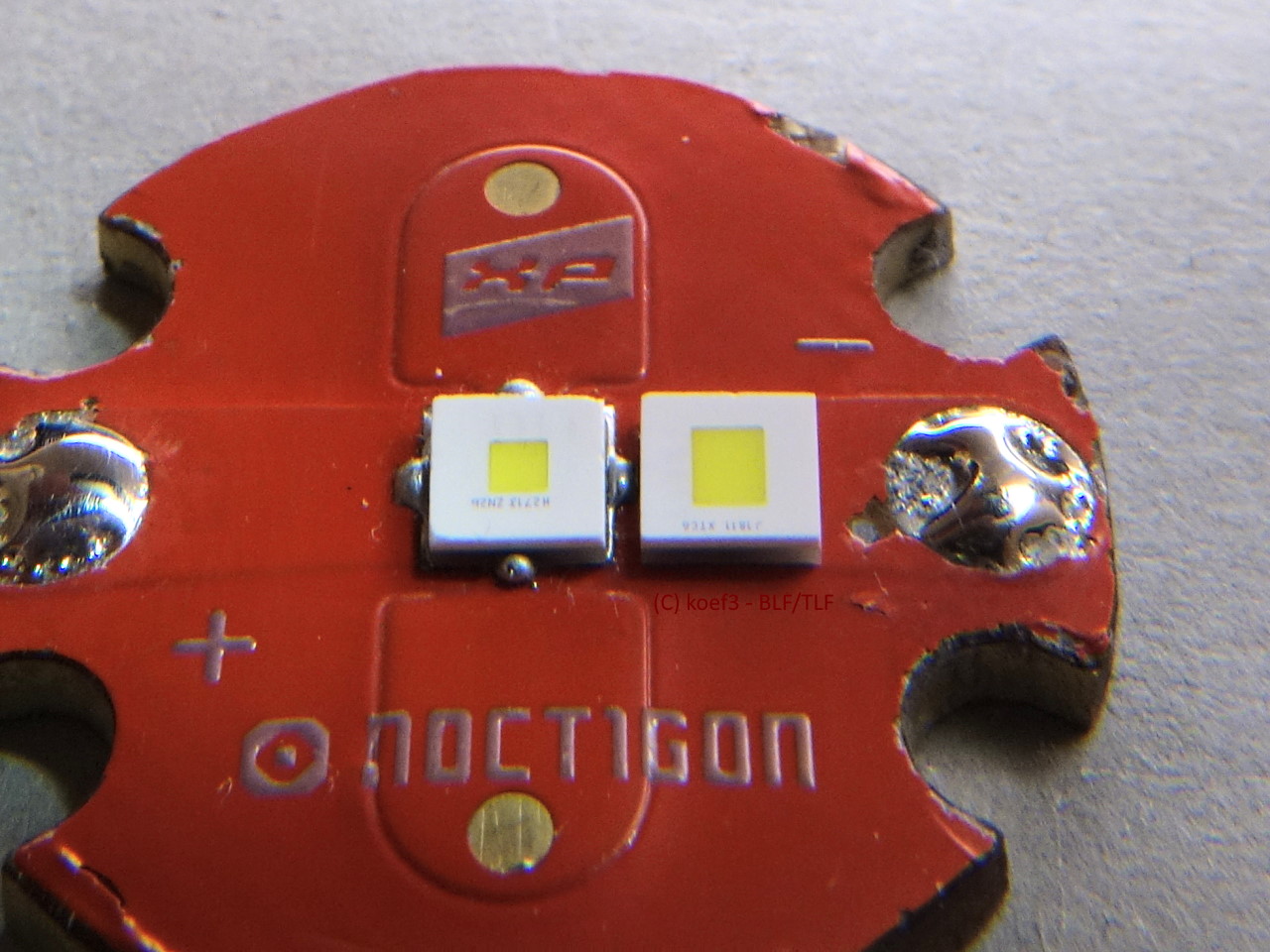
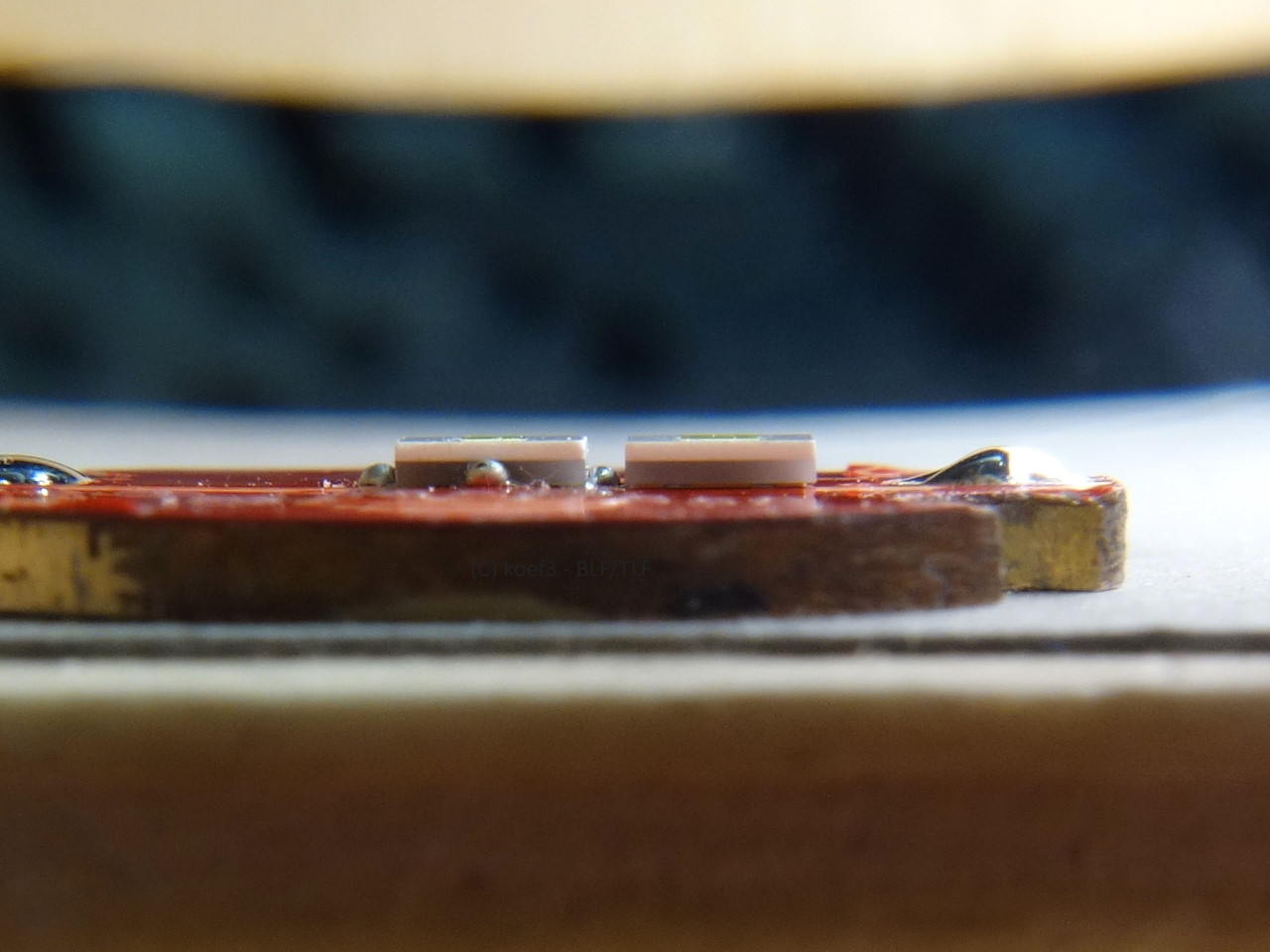
Both LEDs appear identical in the side view. Due to the missing silicone dome, they appear very flat.
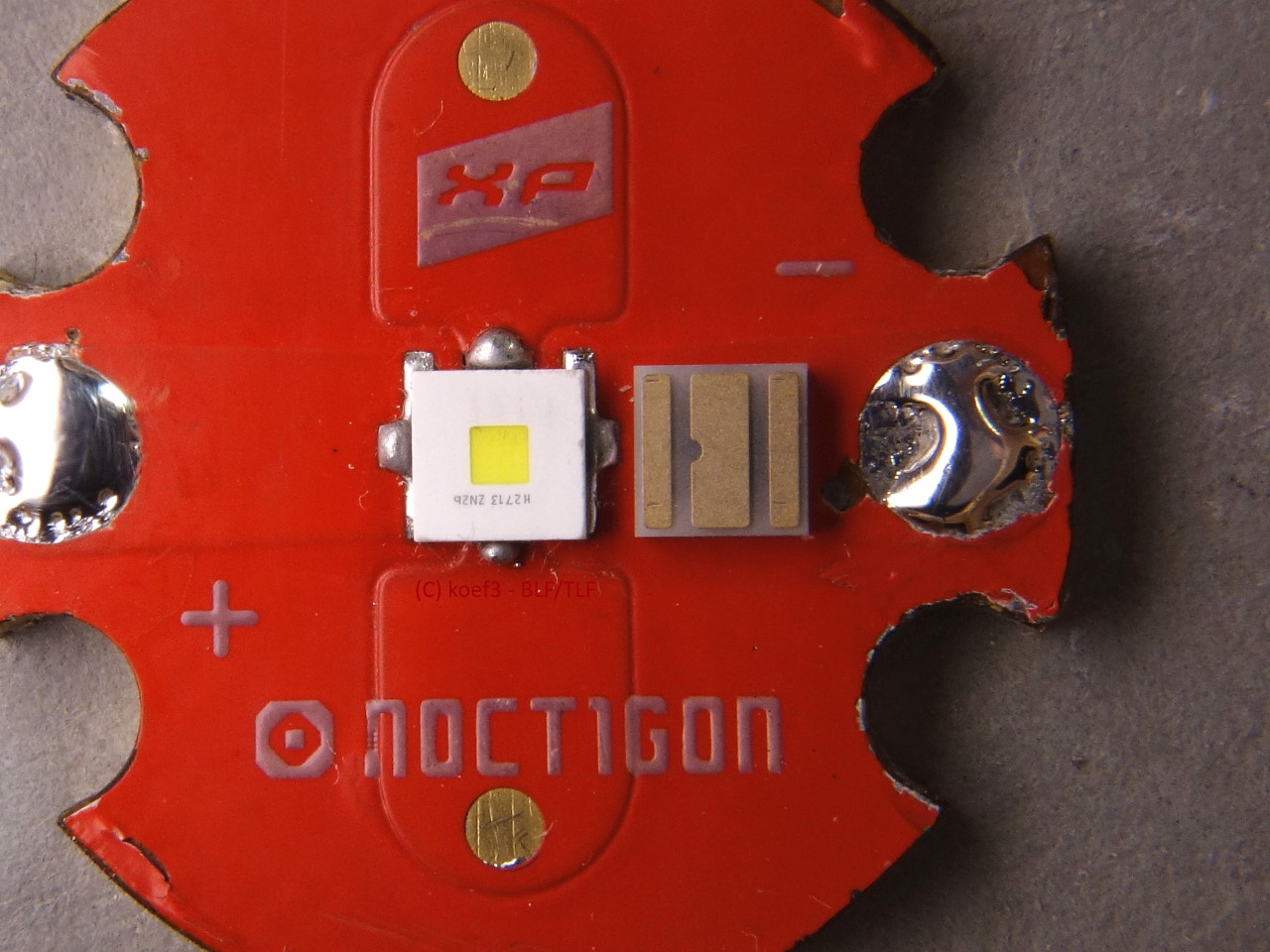
The footprint as well as the housing dimensions correspond to those of other Osram LEDs (called 3030). With existing Osram footprint and accessories this LED can be used freely. Manual soldering on boards with XP footprint (3.45 x 3.45 mm) is possible, but due to the smaller size of the thermal pad it requires high precision and is therefore not designed for automatic/machine placement. Due to the different outer dimensions, centering rings for XP LEDs cannot be used.
Due to the square base area, centering rings produced on a lathe can be used. Due to the increasing spread of flashlights with Osram emitters, an upgrade or exchange is more and more easily possible.
LED chip
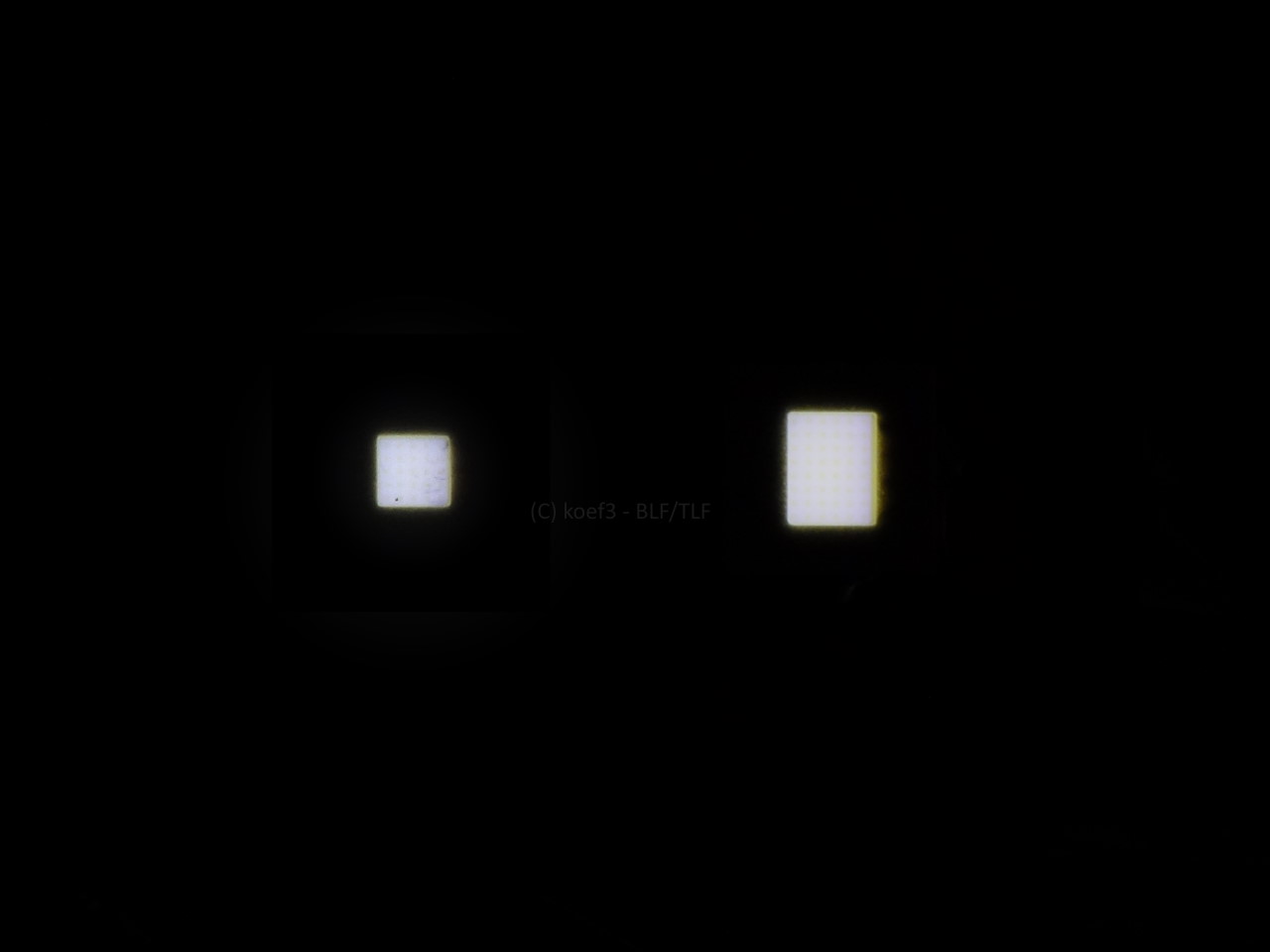
The square luminous area is 1.05 mm² (CSLNM1.TG, left) or 1.93 mm² (CSLPM1.TG, right) in size. Despite the white opaque coating around the luminous surface, there is minimal light leakage, especially with the CSLPM1.TG, which may have an impact on the maximum achievable luminance.
Interestingly, the size and rectangular arrangement of the luminous area is almost exactly the same as the LE UW Q8WP, an earlier design LED that was also manufactured without a dome. I tested this one earlier and it had very high luminance, but was significantly more difficult to handle, especially because of the electrically connected thermal pad.
The electrical parameters and thermal resistance of the CSLPM1.TG are also very similar to the Q8WP, so I suspect that Osram has reused the LED chip from the Q8WP here in a simpler package and with an electrically isolated thermal pad.
There are no cutouts for bonding wires, both LED types are manufactured in flip-chip technology.
Power and overcurrent capabilities

CSLNM1.TG
- at 3,000 mA (official max current): 789 lm @ 3.38 V
- Power at official max current: 10.14 W
- Efficacy at 3,000 mA: 77.8 lm/W
- At 1,000 mA (Binning conditions, 25 °C Tj): 350 lm @ 3.12 V – calculated to 85 °C acc. to Osram datasheet: 322 lm
In contrast to Cree, Osram only divides its LEDs very roughly into power classifications (binnings). The possible luminous flux with the above parameters can vary in the range of 280 to 450 lm. The CSLNM1.TG tested here is about in the middle of this range.
The relatively low drop in luminous flux with increasing temperature is good with these LEDs; at 85 °C Tsp, the luminous flux drops by only about 8 % compared to 25 °C.
Overcurrent:
- Maximum reached at 5,600 mA, at this point 1032 lm @ 3.71 V
- Power at maximum 20.78 W
- Sweet Spot at around 3,600 mA (881 lm @ 3.46 V)
- Power at Sweet Spot 12.5 W
- Efficacy at maximum 49.7 lm/W
- Efficacy at Sweet Spot 70.7 lm/W
As with the Cree XP-P, overcurrenting does bring more power, but it must be weighed in terms of benefit, since the power gain is manageable. It is obvious that Osram is already relatively generous with the maximum current. The power gain is low, which indicates limited heat dissipation, possibly also due to the footprint.
CSLPM1.TG
- at 5,000 mA (official max current): 1212 lm @ 3.32 V
- Power at official max current: 16.6 W
- Efficacy at 5,000 mA: 73.0 lm/W
- At 1,400 mA (Binning conditions, 25 °C Tj): 463 lm @ 2.95 V – calculated to 85 °C acc. to Osram datasheet: 426 lm
The electrical characteristics of the CSLPM1.TG are very similar to those of the smaller model. However, the significantly lower forward voltage is interesting here, which increases the efficiency somewhat. Due to the larger LED chip, the thermal resistance is significantly lower, which benefits the officially permitted maximum current. Osram seems to have generously designed the permissible parameters here as well.
Overcurrent:
- Maximum reached at 8,600 mA, at this point 1499 lm @ 3.62 V
- Power at maximum 31.1 W
- Sweet Spot at around 5,600 mA (1296 lm @ 3.37 V)
- Power at Sweet Spot 18.9 W
- Efficacy at maximum 48.2 lm/W
- Efficacy at Sweet Spot 68.6 lm/W
The low overcurrent potential is also visible with the CSLPM1.TG. Although this LED offers more overcurrent potential due to its lower thermal resistance and larger LED chip, the generous official maximum current of 5 A means that the performance gain is also less significant here and is primarily bought in with higher power consumption. If the maximum luminance is superficial, this approach may seem reasonable, otherwise the operation at the official maximum current is recommended and is also handled this way by most flashlight manufacturers.
As mentioned earlier, the LED chip is quite similar to that of the Q8WP. This is also proven by the diagram; although the maximum current differs slightly (Q8WP: 9,600 mA), the luminous fluxes are relatively close, with the forward voltage of the Q8WP being significantly lower. However, it must be noted here that the groupings in luminous flux and forward voltage are also very coarse for the CSLPM1.TG and this can also simply be due to series spread.
Luminance
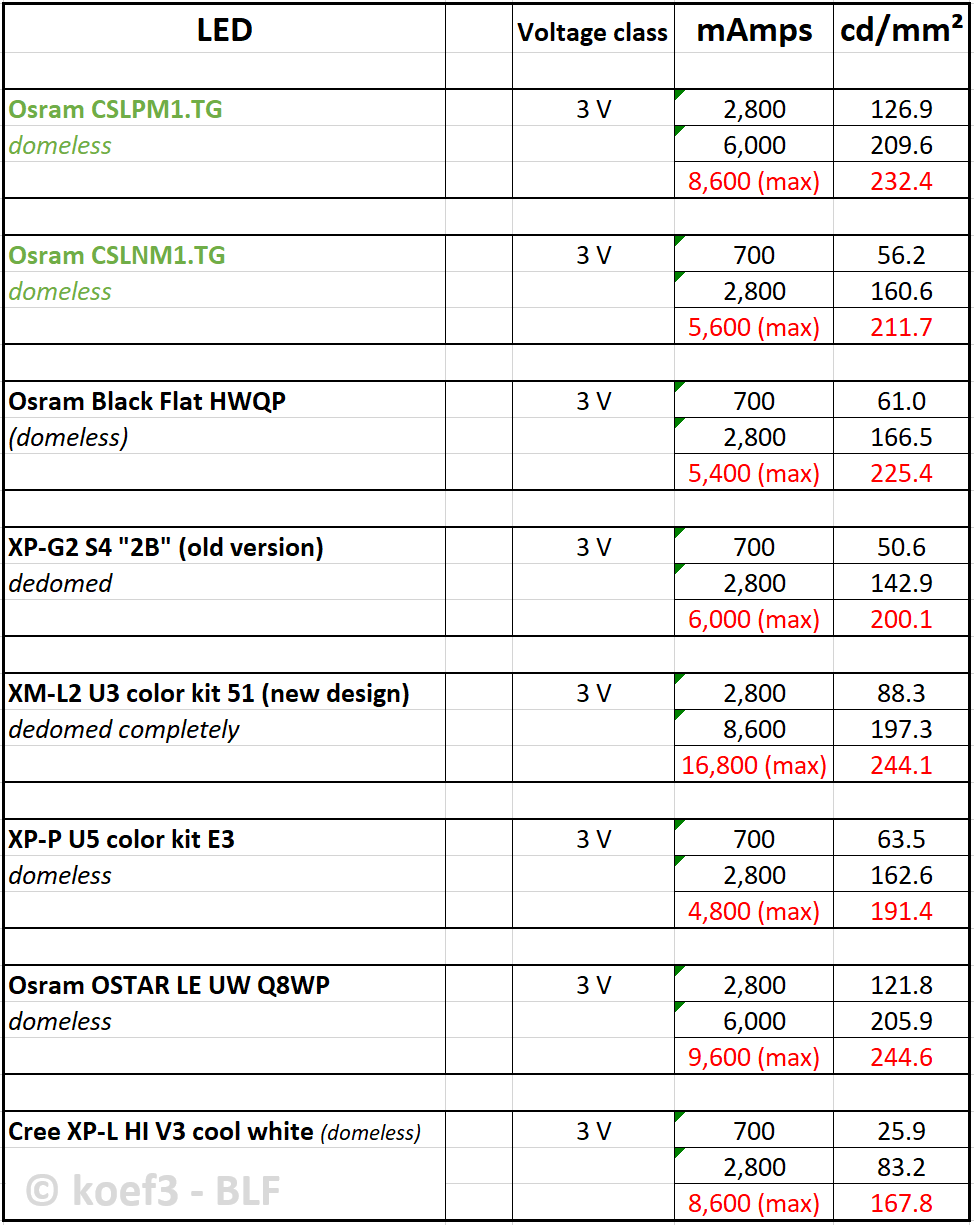
Despite the slightly translucent edge in the casing shown earlier, the luminance of both LEDs is very high. The CSLNM1.TG does not reach the value of the Black Flat HWQP, whereas the CSLPM1.TG passes thanks to its better coolable LED chip and even just overtakes the Black Flat HWQP. Although the Q8WP achieves even higher luminance, it is much harder to procure, more expensive, more difficult to handle and also requires a higher maximum current.
The CSLPM1.TG is an interesting LED for extreme throwers; however, it is important that the maximum current is reached as close as possible, which requires appropriate drivers (buck boost).
I would assume that the old well known dedomed XP-G2 S4 2B is no longer necessary since this LEDs offers higher luminance without the need of changing the emitter mechanically beforehand and at a much lower forward voltage.
Tint and light quality


Both LEDs are sold in the color grouping ebvF46 with the highest possible color temperature (about 6500 K). According to the data sheet, other color groupings are also provided, but these emitters are not available wholesale.
These LEDs do not have coarse color casts. The spectra and measured values are typical for cool white LEDs with low color rendering. There are no conspicuous features.
For applications where high color rendition is important, these LEDs are not suitable because of their poor color rendering indexes.

Use in optics
As already known from previous flashlights available for purchase, use in secondary optics is possible without any problems. There are no color fringes or strong tint shifts.

The picture shows the light image of an original Wuben E6 flashlight with CSLPM1.TG. This light image exemplifies the result of using SMO reflectors and coated glass. Despite the clearly rectangular illuminated area, the spot is clearly delineated and circular. Any rings in the spot are usually due to the quality of the reflector.
Conclusion
There are good reasons to use these two LEDs in flashlights and also for general lighting applications. The light quality in secondary optics is excellent, the light color is usually a clear cool white without strong color casts, and thanks to the electrically isolated thermal pads, use with DTP boards is now also possible without any problems. Although the overcurrent potential beyond the official maximum current is less significant, the luminance is already very high, which makes these LEDs also suitable for extreme lighting applications.
A disadvantage is the wide spread in luminous flux and voltage grouping, and the complete lack of other light colors and color rendering indices.
Pro
- Very high luminance
- Very good light image in optics
- Very high luminance especially up to official maximum current
- Attractive pricing
Neutral
- Overcurrent is hardly worthwhile because of generous official maximum values
Contra
- Very broad luminous flux and voltage groups
- No other color temperatures or Ra available
Thank you for reading the test. I hope this information is helpful for everyone who wants to work with this LED type. 
Greetings, Dominik